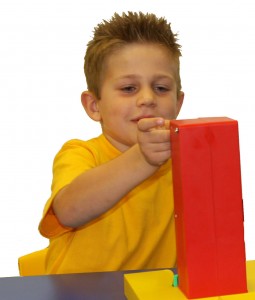 Five year olds usually show well developed communication skills. They should be able to hold a conversation confidently with adults and other children. They are getting ready for the next stage of language, literacy!
Five year olds usually show well developed communication skills. They should be able to hold a conversation confidently with adults and other children. They are getting ready for the next stage of language, literacy!
Five year olds should be able to:
- Tell you what things are for: “you cut things with scissors”
- Use sentences of five to seven words or more
- Understand concepts and opposites such as: wet/dry, hard/soft , same/different, before/after and position words such as: on top, behind, through,understand same/different, count ten things and name colours
- Listen to and understand stories and retell them from the pictures
- Use past, present and future tense and grammar words such as “he” and “she”
- Ask and answer “why” and “how” questions
- Describe their feelings with words such as: happy, sad, mad
Five year olds are beginning school. This means they should be ready for more formal teaching of literacy. Some of the skills needed for learning literacy include:
- Being able to hear beginning sounds in words
- Being able to match and make rhyming words
- Being able to clap or count the syllable beats in words
- Recognising letters and the sounds they make
- Being able to write their own name
- Understanding the structure of a story with a beginning, middle and end
To develop your five year old’s understanding try to talk at a level just above the level your child uses themselves. If your child uses sentences of five words, make yours just a little longer. Introduce new words and concepts as you talk with your child. Repeat the new word or idea a number of times to help your child learn and remember. Use the new word in different settings so that your child develops a deeper understanding of the word.
To develop your five year old's use of language repeat back their sentences to them now and then fixing up any mistakes. “I’ve got cold foots” “Cold feet, oh no let get some warm socks”. This will help them gradually learn adult grammar and pronunciation. Gently emphasize your change but make sure you also sound interested and positive. Also add extra words and ideas to what your child says; “I found a bug” “You found a tiny, green bug, let’s look for another one, let’s find another tiny, green, bug”. Most importantly listen to what your child has to say and make talking together a positive time for both of you.
Help your five year old develop language skills by:
Immersing your child in language. Talk together as often as you can. Talk about what your child has done in the day and what you have done. Talk about what they play, draw and watch on TV. Talk together as you do household tasks, encouraging your child to be involved as you cook, clean, shop and garden.
Encouraging your child to share their experiences using language. Encourage your child to share what they have seen, done and made with others. Call Grandma and tell her what you did at school. Show dad what you drew and tell him all about it. Talking with others about something that happened in another time and place helps develop "decontextualised language", the ability to talk about something that happened in another context. This is an important pre literacy skill. Give your children something concrete to talk about to start with. Help them show something they drew or made and talk about it or use photos or video clips of things you have done to share with family and friends.
Helping your child learn to link sentences into "texts".
A text is something more than a sentence. A text can be:
- a "procedure", how to do something such as how to make toast
- a recount, telling about something you have done
- a narrative or story
- a description
- a discussion, explanation or argument
Children who can link sentences together when they are talking do better when they have to write texts. You can practice making texts when talking about daily activities such as:
- telling how you did something such as a craft or cooking activity
- recounting an event or outing
- retelling a story from the pictures in a book
- describing an object to someone
- explaining why you did something or why you should do something
Linking your child's spoken language to written language by:
- practising writing your child's name together and write it on things that belong to them
- looking at the words on signs, labels, advertising, magazines and books and talking about them together
- providing a variety of reading and writing materials for your child to use such as paper, note pads, pencils, books, magazines, letter puzzles and games
- making your own books using photos of your child's experiences and writing the words together.
- reading lots of stories and talking about the story but also about the words and the way the book is written, such as a title at the front, words telling about the pictures, the name of the author, they way the story has a beginning, middle and end.
Check Our website for more ideas on language and literacy.
Related Blog Posts
If you liked this post you may also like:
What is autism?
Developmental delay
A mum's 10 ASD therapy tips
What is dyslexia?



